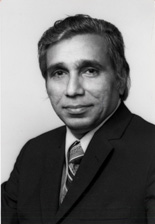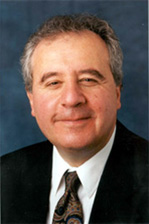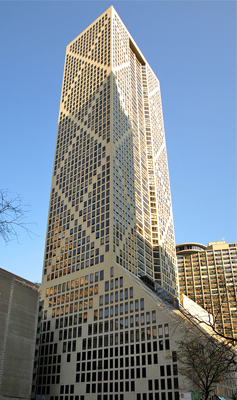Lehigh University
Office or Center Name Here
The Fazlur Rahman Khan Endowed Chair of Structural Engineering and Architecture
 |
|
Fazlur R. Khan |
The Sears Tower, now the Willis Tower, (the tallest building in the United States until 2014, and the tallest in the world until 1996) and the 100-story John Hancock Center in Chicago are two of the many impressive structures Fazlur Rahman Khan designed during his short life (1929-1982). The Hajj Terminal at King Abdulaziz International Airport in Jeddah, Saudi Arabia, is a third.
One of the foremost structural engineers of the 20th century, Fazlur Khan epitomized both structural engineering achievement and creative collaborative effort between architect and engineer. Only when architectural design is grounded in structural realities, he believed - thus celebrating architecture's nature as a constructive art, rooted in the earth - can "the resulting aesthetics ... have a transcendental value and quality." It is in this spirit that Lehigh University endowed this chair in his honor, and established the Khan Lecture Series. (For more information on Fazlur Rahman Khan, please click here.)
Lehigh appointed Dan M. Frangopol, an expert in structural reliability, optimization, and life-cycle engineering, as the university's first holder of the Khan Chair. In this capacity, he also organizes Lehigh's Fazlur R. Khan Distinguished Lecture Series.
 |
|
Dan Frangopol |
Frangopol, who came to Lehigh from the University of Colorado at Boulder, has set up research directions in two areas for which he has a passion - life-cycle engineering and the maintenance and management of bridges and other structures. Life-cycle engineering, says Frangopol, optimizes the investment made in an individual structure or network of structures by considering multiple and conflicting objectives during a specified time horizon. It employs probability and statistics to account for the changes structures undergo during their lifetime. It provides decision makers different solution options from which the one that preferably balances structural performance enhancement and cost reduction can be selected.
"Our knowledge to model, analyze, design, maintain, manage and predict the life-cycle performance of civil infrastructure systems is continually growing. However, the complexity of these systems continue to increase and an integrated approach is necessary to understand the effect of technological, environmental, economical, social and political interactions on the life-cycle performance of engineering infrastructure. In order to accomplish this, methods have to be developed to systematically analyze structure and infrastructure systems, and models have to be formulated for evaluating and comparing the risks and benefits associated with various alternatives. We must maximize the life-cycle benefits of these systems to serve the needs of our society by selecting the best balance of the safety, economy and sustainability requirements despite imperfect information and knowledge."
"A structure should be planned and built for a life cycle of 50 to 100 years, or more," he says. During this time, structures may be exposed to abnormal loads of different types, ranging from natural hazards (such as earthquakes, floods, and hurricanes) to man-made disasters such as terrorist attacks, fires, or vehicular collisions). At the same, structural performance undergoes gradual deterioration due to material aging, harsh environmental conditions, and increasing loads.
"From the beginning, you should estimate how much money you need to spend to optimize the cost of maintaining and repairing structures over their lifetime."
"Civil engineering structures react to a complex set of variables that change as a structure ages. In order to make smart decisions that optimize the safety, reliability and cost of these structures over their lifespans, we must apply resources in design, construction, maintenance and monitoring as effectively as possible. Civil engineering, information technology, and cost-risk analysis join to create a comprehensive approach to managing all the variables that impact the long-term health of a structure."
ASCE-produced video announcing Frangopol's Distinguished Membership. (YouTube, 2:41) |
In late 2010, Frangopol joined a select group of leaders in the field of civil engineering when he was inducted as a Distinguished Member of the American Society of Civil Engineers (ASCE). As ASCE's highest accolade, Distinguished Membership recognizes eminence in a branch of engineering, and is currently comprised of only 192 of the Society's 144,000 members worldwide.
A Foreign Member of the Royal Academy of Belgium for Science and the Arts, a Foreign Member of the Academia Europaea (Academy of Europe, London) and an Honorary Member of the Academy of Technical Sciences of Romania. Prof. Frangopol holds 4 honorary doctorates and 12 honorary professorships.
Frangopol is the Founding President of the International Association for Bridge Maintenance and Safety (IABMAS) and of the International Association for Life-Cycle Civil Engineering (IALCCE). He also serves as the Vice President of the International Association for Structural Safety and Reliability (IASSAR). Frangopol is Past Vice President of both the International Society for Structural Health Monitoring of Intelligent Infrastructure (ISHMII), Past Vice-President of the Engineering Mechanics Institute of ASCE and Past member of its Board of Governors.
Frangopol is also the Founding Editor-in-Chief of Structure and Infrastructure Engineering, an international peer-reviewed journal, included in the Science Citation Index, dedicated to advances in maintenance, management and life-cycle performance of a wide range of infrastructures. He is the recipient of several prestigious awards, including the OPAL (Outstanding Projects and Leaders) Leadership Award for Lifetime Accomplishments in Education, the Alfred Ang Award on Risk Analysis and Management of Civil Infrastructure, the Arthur M. Wellington Prize, the Ernest Howard Award, the T. Y. Lin Medal, the Nathan M. Newmark Medal, the Fazlur R. Khan Medal, the Moisseiff Award, and the J. James R. Croes Medal, among others.
The Fazlur R. Khan Distinguished Lecture Series has been initiated and organized by Dan M. Frangopol, the first holder of Lehigh's Fazlur Rahman Khan Endowed Chair of Structural Engineering and Architecture.

Onterie Center
The Fazlur R. Khan Distinguished Lecture Series honors Dr. Khan’s legacy of excellence in structural engineering and architecture.